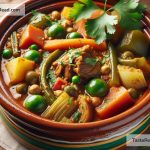Exploring the Origins of the Nigerian Suya: A Culinary Journey Through Time
Nestled within the vibrant streets of Nigeria, amidst the bustling markets and colorful scenery, lies a dish that has captured the hearts of many – the Nigerian Suya. This delectable skewered meat dish isn’t just a culinary delight; it’s a cultural experience, offering a taste of Nigerian heritage and tradition. But where did Suya originate, and how did it become such an integral part of Nigerian cuisine? Let’s embark on a journey through time to explore the origins of the Nigerian Suya.
The Roots of Suya
Suya’s journey begins in the northern regions of Nigeria, where it is believed to have been conceived. Its creation is attributed to the Hausa people, one of the largest ethnic groups in West Africa. The Hausa community, known for their rich culture and traditions, has played a pivotal role in the spread and popularization of Suya across Nigeria and beyond.
Originally, Suya served not just as a tasty snack but as a means of preserving meat. In the days before refrigeration, the Hausa people needed a method to keep their meat fresh for longer periods. By slicing the meat into thin strips, marinating it in a blend of spices, and then drying or smoking it, they were able to extend its shelf life. Thus, Suya was born out of necessity, turning into a beloved delicacy over time.
The Suya Spice: A Blend of Tradition
What sets Suya apart from other grilled meat dishes is its unique spice blend, known as Yaji. This spice mix is the heart of Suya, giving it its distinctive flavor. While the precise ingredients can vary, Yaji typically contains ground peanuts or peanut powder, paprika, ginger, and several other spices. This special blend not only flavors the meat but also tenderizes it, ensuring that every bite is succulent and bursting with taste.
The preparation of Suya is as much an art as it is a science. The meat, often beef, chicken, or ram, is carefully sliced into thin pieces, marinated in the Yaji spice mix, and then skewered. These skewers are then grilled over an open flame, traditionally charcoal, to impart a smoky flavor that complements the spicy marinade beautifully.
Suya: More Than Just a Meal
In Nigeria, Suya isn’t merely food; it’s a cultural phenomenon. It’s common to find Suya spots, locally known as “Suya joints,” at street corners and markets, especially in the evenings. These joints, often run by skilled Suya chefs known as “Mai Suyas,” become gathering places where people from all walks of life come together to savor this delicious treat under the night sky.
Suya is also a unifying factor in a country as diverse as Nigeria. Despite its origins in the north, Suya has transcended regional boundaries to become a national favorite. Its popularity attests to the ability of food to bring people together, fostering a sense of community and shared identity.
The Global Journey of Suya
As Nigerians have ventured across the globe, they’ve taken Suya with them, introducing it to a global audience. Today, you can find Suya being served in cities from London to New York, a testament to its universal appeal. While it may undergo some adaptations to cater to different palates, the essence of Suya remains the same, captivating hearts and taste buds worldwide.
Conclusion
The story of Suya is a narrative of culture, tradition, and innovation. From its humble beginnings as a preservation technique to its status as a beloved street food and international delicacy, Suya has traveled through time, transcending its origins to become a symbol of Nigerian culinary heritage.
As we explore the origins of the Nigerian Suya, we’re reminded of the power of food to tell stories, preserve history, and bring people together. Suya isn’t just a dish; it’s a celebration of Nigerian culture, a testament to the creativity and resilience of its people, and a delicious invitation to explore the rich tapestry of African cuisine.


